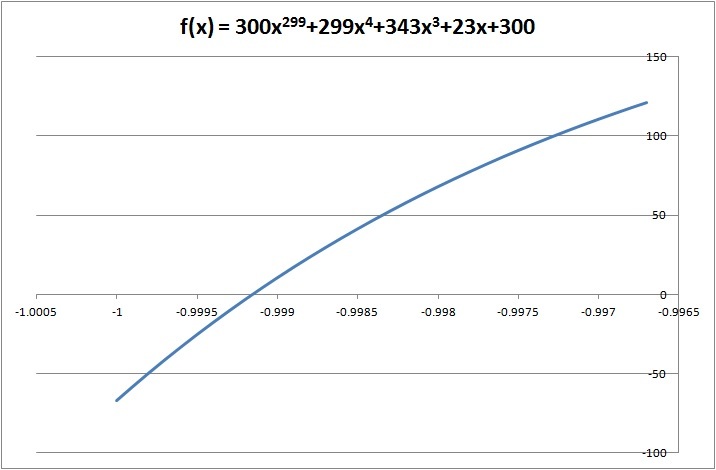300 Followers question!
3 0 0 x 2 9 9 + 2 9 9 x 4 + 3 4 3 x 3 + 2 3 x + 3 0 0 = 0
If α is the real root of the equation above, find ⌊ α ⌋ .
The answer is -1.
This section requires Javascript.
You are seeing this because something didn't load right. We suggest you, (a) try
refreshing the page, (b) enabling javascript if it is disabled on your browser and,
finally, (c)
loading the
non-javascript version of this page
. We're sorry about the hassle.
3 solutions
Let f ( x ) = 3 0 0 x 2 9 9 + 2 9 9 x 4 + 3 4 3 x 3 + 2 3 x + 3 0 0 . We note that: f ( 0 ) = 3 0 0 and f ( − 1 ) = − 6 7 . Therefore, there is a real root of f ( x ) in − 1 < x < 0 . And this is the only root because for x < − 2 or x > 2 , f ( x ) ≈ 3 0 0 x 2 9 9 a constantly increasing function. Therefore, − 1 < α < 0 ⇒ ⌊ α ⌋ = − 1 .
The following graph shows the real root α .

By observation, it is clear that the root is negative as the expression is positive for x>0 and equals 300 at x=0.Now by some hit and trial f(-1)<0 => f(0)*f(-1)<0=> The real root lies between -1 and 0 => [alpha]=-1
We can do this by eradicating cases.
If α > 0 we see that whole expression always remains positive.
If α < − 1 we see that 3 0 0 x 2 9 9 becomes too much large for the expression to be zero , making the polynomial always negative.
So we can easily conclude that − 1 < α < 0 and hence ⌊ α ⌋ = − 1